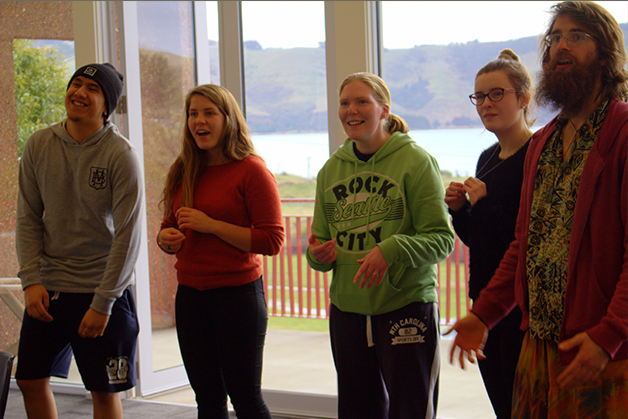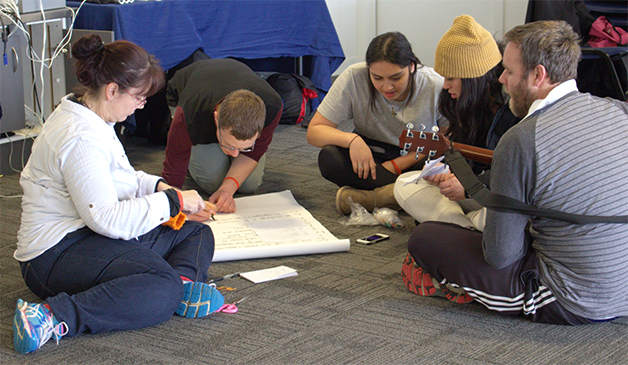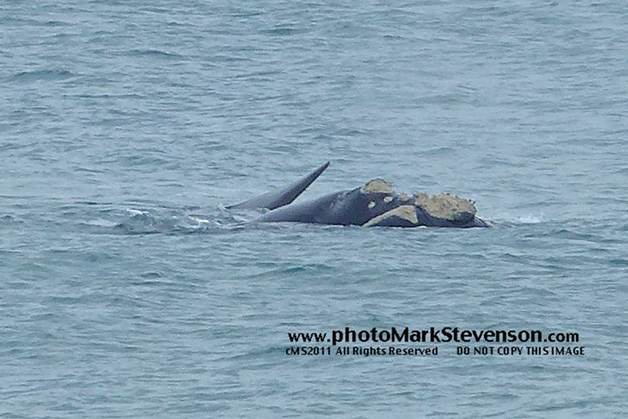Immersion Māori language hui
First, second and third year Māori studies students from Te Tumu University of Otago held a noho marae at Ōtākou from 31 July-1 August. The hui was sponsored by Megan Pōtiki and it was with fun company, great kai and the warm venue made up for the dull winter weather, and ensured lots of learning was accomplished.

The students practising a waiata at the marae.

The tauira hard at work.
Archaeology visit
A group of fourth year archaeology students from University of Otago visited the marae on 22 July, to conduct an experiment using a very abstract approach in archaeology known as phenomenological archaeology.
Phenomenological archaeology draws on anthropological theory to focus on landscape, how it is ordered and how groups of people may experience that landscape and the structures or monuments within it.
The approach grew out of work published by Chris Tilley, a British archaeologist who used the theory to determine how Neolithic people may have interacted with Stonehenge and its landscape.
The purpose of the experiment was to assess whether an ‘uninformed’ group interacted with the landscape and structures on the marae in a different way to an ‘informed’ group, and how the landscape and structures influenced movement around the grounds. (We have a chocolate fish for the first person who can phone into our office 03 478 0352 and say the word phenomenological correctly).

One of the lesser known ‘structures’ on the marae that influences movement – the old sled track that went over the hill from the marae to Pipikaretu Beach.

Fourth year archaeology students from the University of Otago.
Whale sightings
We have had a few Humpback Whale sightings in the last month at the tail end of the northward migration to the tropics. An adult and juvenile were seen by The Monarch at the Harbour entrance on Sunday 12 July, and later near Fish reef at Moeraki. On 16 July, one of our DOC rangers Lyndon Perriman saw a humpback and calf half a nautical mile out from Taiaroa Head at around 12 noon – it is rare to see a calf born this far south.
Earlier in the season another calf was seen during the Cook Straight survey, which was reported to be only the second seen in New Zealand. http://www.doc.govt.nz/news/media-releases/2015/humpback-whale-baby-only-second-seen-in-new-zealand/
The Monarch then saw another two to three Humpbacks on 24 July, one nautical mile north east of the Taiaroa lighthouse. Southern Right Whales have also been spotted – a juvenile was seen off Puddingstone Rocks on the 7 July and another was seen just off the St Clair/St Kilda Beach on the afternoon of 14 July.

Southern Right Whale off St Clair, Dunedin spotted on 14 July. This picture helps to give an idea of the length and head of the whale. Photo by Mark Stevenson.
Marine hui
The South-East Marine Protection Forum (SEMPF) hui was held at Puketeraki on 26 July. This is an important kaupapa and a follow-up hui will be held on 23 August.
The SEMPF is engaged in a marine protection process that will set the course for management of our marine environment for at least the next 50 years. They are due (in late August) to begin identifying areas off the Otago Peninsula for protection prior to assessing areas further south to the Mataau/Clutha. The hui was an opportunity for Kāi Tahu of Otago including Tangata Tiaki to influence the assessment and potential location of the marine protection network tools that include marine reserves and fisheries management tools.
Statue unveiling
On Sunday 12 July the New Zealand Sea Lion Trust (NZSL) unveiled the statue of sea lion matriarch ‘Mum’ and her pup. Around 80 people braved the cold and attended, including Robyn Aston and George McIntosh and his son from the Moturata whānau, Taieri.
‘Mum’ was the first sea lion in 150 years to give birth on the mainland some 20-years-ago along the Taieri coast. She produced pups on the Otago coast until 2010, when she disappeared at the age of 24. When ‘Mum’ first gave birth it was on or below Georges property at Taieri Mouth, George looked out for them, sometimes spending hours on the beach protecting them.
At least one pup named Whetu Rere is known to have died. Department of Conservation (DOC) ranger Jim Fyfe and NZSL Trust chairman Steve Broni hope that research into this small community of New Zealand sea lions on the Otago Peninsula could shed new light on why these critically endangered mammals are doing well here but far worse on the Auckland Islands.
Future events
Hākui Exhibition
On 19 November at 6pm at the Otago Museum the Hākui Exhibition will be opening and it will run for six months.
Hui-ā-Iwi 2015
Friday 20-Sunday-22 November at the Dunedin City Town Hall.